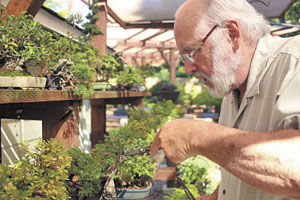There is something calming about watching Gordon Deeg prune his azaleas. The tree, which actually is a bush, is one of Deeg’s more prized bonsai art pieces and was shown earlier this month at the annual bonsai show at the San Mateo Garden Center.
“It’s a bit fried,” he said, as he continued to pull off wrinkled bits of flower from the side of the tree.
With every pinch and pull, the leftover stamen would hang off the branches and droop, giving the look of tinsel on a very tiny Christmas tree — which is fitting because Deeg, himself, looks a bit like Santa Claus.
He’s a graying man with a thick white beard. By hands that have the strength to tightly twist copper wire around tree branches, he uses a soft touch to handle dwarfish trees that look like they could be blown away with a small gust of wind.
Deeg’s Atherton backyard has well over a dozen rows lined with tiny elms, junipers and redwoods along with a bleacher of smaller trees under 8 inches, called shohin trees. And even though maintaining the trees has compromised his time, which Deeg said is a full-time position, there is a pull to bonsai trees that Deeg can’t shake.
“The problem with bonsai is that you get one, then you get two and then you go to bed at night and wake up and there are three — you don’t know where it comes from,” he said. “This is what I do. And I don’t do enough of it.”
An ancient, and now expensive, ritual
Originally a Chinese art form, bonsai started 2,300 years ago in the form of penjing, a practice meant to miniaturize and recreate full landscapes of mythical origin to harness its powers.
The practice was later adopted by the Japanese monks in the Kamakura period who, in turn, viewed a single tree in a pot as representative of the whole universe.
“The Japanese, when they got ahold of it, they took it to a whole different level,” said Deeg.
The United States didn’t experience bonsai in pop culture until the 1940s, well after the Japanese migrated in droves to San Francisco. But within a few decades, bonsai trees in America went from paper weights to popular social clubs, with hundreds of bonsai clubs throughout the nation, each putting on an individual bonsai show. And there are larger scale national and international shows, where trees can go for as high as $1.2 million, as was the case in November 2011 at the 11th Annual Asia-Pacific Bonsai and Suiseki Convention & Exhibition in Japan.
The price tag of bonsais haven’t eluded thieves, though, who are looking to cash in.
This last May, a 60-year-old bonsai tree worth between $2,000 and $3,000 was stolen from the Pacific Bonsai Museum in Seattle, Washington. Another incident in May 2014 included $65,000 worth of bonsai trees being stolen from a nursery in Vancouver, British Columbia. In 2012, a bonsai tree worth $25,000 was stolen from a garden in Bremerton, Washington, and in 2013 six trees valued up to $1,200 were stolen from a Japanese Friendship Garden in San Diego.
Recommended for you
According to gathered news reports across the nation over the past three years, the total loss of bonsais stolen is over $300,000.
The calling
The intricacies of creating the perfect bonsai tree is complex and lends itself to a kind of harmonic science that bonsai creators have come to embrace; cut off one branch, and in its place a leaf will grow, or tear off a side and let the deadwood become a part in the visual aesthetic.
But there is also a very real science behind how bonsais are maintained. After all, trees aren’t meant to be small, especially pomegranate trees, which Deeg has placed in his backyard that are years old, fully grown and stand less than 8 inches tall — smaller than the fruit they bear.
The members of the San Mateo bonsai group learn botany to manipulate the trees’ growth, forcing nutrients into one area of a tree or allowing sunlight to reach a specific piece of shrubbery.
“Bonsai and bonsai culture and learning to maintain and develop trees is a learned craft and that craft you make into art, like any art form,” Deeg said. “We look at botanical features and look at how nutrients come up through the trees and we use that.”
There are three categories that a bonsai tree must meet for it to be considered a “good” bonsai: it has to look old, it has to look like something from nature and it has to look pretty.
“You look at it, and for the people that it affects, it does something to them,” said Deeg.
Crafting the look is arduous work, he says, and for those that meet once a month with the Sei Boku Bonsai Kai club at the San Mateo Garden Center, where Deeg is a leader, understanding that balance of knowing what to cut and where is something of a nail-biting moment.
“New people freak out when I do this,” Deeg said as he cuts off a massive branch from a juniper, leaving one side naked and exposed.
“But you see that shrub there?” he asked and pointed to a small piece of green poking out of the base of the branch. “I want that to grow. And in order to do that, you have to get rid of some.”
And Deeg said that in those moments of tearing off large pieces of wood from such small trees, there’s a lesson to be learned in letting things go.





















(0) comments
Welcome to the discussion.
Log In
Keep the discussion civilized. Absolutely NO personal attacks or insults directed toward writers, nor others who make comments.
Keep it clean. Please avoid obscene, vulgar, lewd, racist or sexually-oriented language.
Don't threaten. Threats of harming another person will not be tolerated.
Be truthful. Don't knowingly lie about anyone or anything.
Be proactive. Use the 'Report' link on each comment to let us know of abusive posts.
PLEASE TURN OFF YOUR CAPS LOCK.
Anyone violating these rules will be issued a warning. After the warning, comment privileges can be revoked.